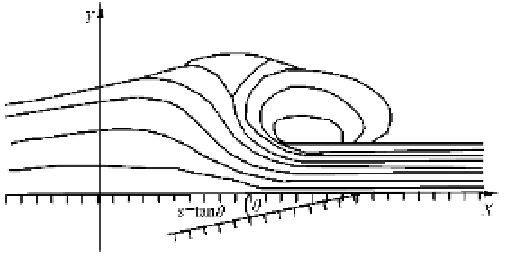Environmental Engineering Reference
In-Depth Information
where
u
is the initial perturbation in velocity, W
B
is the yield shear stress, K is the rigidity coefficient,
h
is the flow depth, g is the acceleration of gravity, U is the density and
d
is the thickness of the shearing
layer, and Fr is the Froude number of the flow. The derivation of the equation is given in Appendix 1 of
this Chapter.
Fig. 4.46
A fully developed roll wave. The streamlines are seen by a viewer moving with the wave. A part of the mud
moves upward like a fountain under the extrusion of the wave. Then it divides into two parts, one part flows forward and
other part flows at a velocity less than the wave speed and gradually lags behind the wave (after Wang et al., 1990)
If the fluid has a large yield stress and the Froude number is larger than one, the flow will be very
unstable and quickly develops into roll waves. Many viscous debris flows in the Jiangjia Ravine are
examples of such flows (Kang, 1985b). If the Froude number is smaller than one but the rigidity coefficient,
K, is small and the yield stress is large, the flow also is unstable and develops into wave flow. Some
unstable hyperconcentrated flows in the tributaries of the Yellow River are examples of this type of flow.
Whereas if the yield stress is small and K is large, a non-Newtonian flow is stable at low Froude numbers,
e.g., flows of crude oil and lava are stable because magma has an extremely high rigidity coefficient.
In pseudo-one-phase debris flows, the development of roll waves is essentially due to the yield stress
of the debris mixture. Normalizing the two terms on the right hand side of Eq. (4.8) with the acceleration
of gravity,
g,
as follows, Wang (2002) defined two dimensionless numbers,
S
y
and
S
vis
, to represent the
effects of yield stress and viscosity:
W
(4.10a)
S
B
y
g
U
h
m
K
u
(4.10b)
S
vis
g
U
hd
m
It may be derived from the theory of motion that the any perturbation of the flow depth may develop
into a large wave if
S
y
is large. The growth rate of the perturbation wave height per distance is given as
follows:
'
h
W
J
1
B
S
(4.11)
y
L
2
h
2
m
Equation (4.11) explains that the larger is the yield stress and the smaller is the flow depth, the higher
will be the growth rate of the perturbation wave. The measured growth processes in the experiments are
shown in Fig. 4.47, which shows that the growth rate of waves is proportional to
S
y
, agreeing with the
theoretical conclusion. Nevertheless, the exact growth rate of the perturbation waves is smaller because
the assumption of K = 0 used for deriving Eq. (4.11) is not true.
In summary, pseudo-one-phase debris flows or flows of other non-Newtonian fluids may develop into
roll waves essentially due to the yield stress of the fluid. 1) The free-surface is unstable and roll waves





Search WWH ::

Custom Search